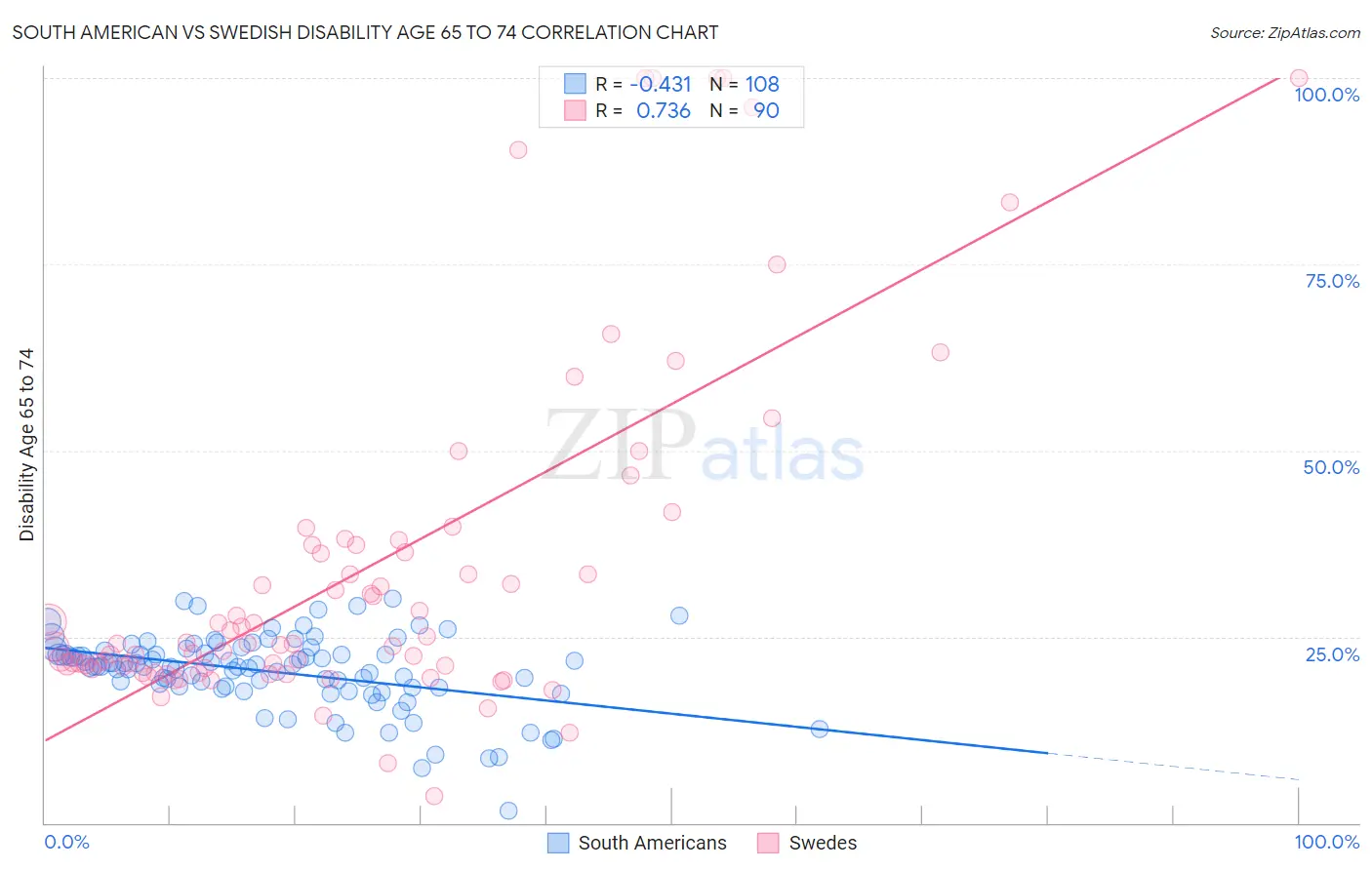South American vs Swedish Disability Age 65 to 74
COMPARE
South American
Swedish
Disability Age 65 to 74
Disability Age 65 to 74 Comparison
South Americans
Swedes
22.2%
DISABILITY AGE 65 TO 74
96.4/ 100
METRIC RATING
103rd/ 347
METRIC RANK
22.4%
DISABILITY AGE 65 TO 74
94.7/ 100
METRIC RATING
117th/ 347
METRIC RANK
South American vs Swedish Disability Age 65 to 74 Correlation Chart
The statistical analysis conducted on geographies consisting of 492,506,151 people shows a moderate negative correlation between the proportion of South Americans and percentage of population with a disability between the ages 65 and 75 in the United States with a correlation coefficient (R) of -0.431 and weighted average of 22.2%. Similarly, the statistical analysis conducted on geographies consisting of 537,372,214 people shows a strong positive correlation between the proportion of Swedes and percentage of population with a disability between the ages 65 and 75 in the United States with a correlation coefficient (R) of 0.736 and weighted average of 22.4%, a difference of 0.60%.

Disability Age 65 to 74 Correlation Summary
| Measurement | South American | Swedish |
| Minimum | 1.6% | 3.7% |
| Maximum | 30.2% | 100.0% |
| Range | 28.6% | 96.3% |
| Mean | 20.3% | 34.3% |
| Median | 21.0% | 24.0% |
| Interquartile 25% (IQ1) | 18.2% | 20.8% |
| Interquartile 75% (IQ3) | 22.9% | 37.4% |
| Interquartile Range (IQR) | 4.6% | 16.6% |
| Standard Deviation (Sample) | 5.0% | 23.2% |
| Standard Deviation (Population) | 5.0% | 23.0% |
Demographics Similar to South Americans and Swedes by Disability Age 65 to 74
In terms of disability age 65 to 74, the demographic groups most similar to South Americans are Colombian (22.2%, a difference of 0.010%), Immigrants from Saudi Arabia (22.2%, a difference of 0.020%), Immigrants from England (22.2%, a difference of 0.050%), Palestinian (22.2%, a difference of 0.050%), and Uruguayan (22.2%, a difference of 0.060%). Similarly, the demographic groups most similar to Swedes are Austrian (22.4%, a difference of 0.0%), Brazilian (22.4%, a difference of 0.010%), Immigrants from Northern Africa (22.4%, a difference of 0.010%), Laotian (22.3%, a difference of 0.050%), and Ukrainian (22.3%, a difference of 0.12%).
| Demographics | Rating | Rank | Disability Age 65 to 74 |
| Uruguayans | 96.5 /100 | #100 | Exceptional 22.2% |
| Immigrants | England | 96.5 /100 | #101 | Exceptional 22.2% |
| Immigrants | Saudi Arabia | 96.4 /100 | #102 | Exceptional 22.2% |
| South Americans | 96.4 /100 | #103 | Exceptional 22.2% |
| Colombians | 96.4 /100 | #104 | Exceptional 22.2% |
| Palestinians | 96.3 /100 | #105 | Exceptional 22.2% |
| Peruvians | 96.1 /100 | #106 | Exceptional 22.2% |
| Slovenes | 96.1 /100 | #107 | Exceptional 22.2% |
| Immigrants | Zimbabwe | 96.1 /100 | #108 | Exceptional 22.3% |
| Albanians | 95.8 /100 | #109 | Exceptional 22.3% |
| Immigrants | Peru | 95.7 /100 | #110 | Exceptional 22.3% |
| Serbians | 95.7 /100 | #111 | Exceptional 22.3% |
| Immigrants | South America | 95.5 /100 | #112 | Exceptional 22.3% |
| Syrians | 95.3 /100 | #113 | Exceptional 22.3% |
| Ukrainians | 95.1 /100 | #114 | Exceptional 22.3% |
| Laotians | 94.9 /100 | #115 | Exceptional 22.3% |
| Brazilians | 94.8 /100 | #116 | Exceptional 22.4% |
| Swedes | 94.7 /100 | #117 | Exceptional 22.4% |
| Austrians | 94.7 /100 | #118 | Exceptional 22.4% |
| Immigrants | Northern Africa | 94.7 /100 | #119 | Exceptional 22.4% |
| Immigrants | Kazakhstan | 93.9 /100 | #120 | Exceptional 22.4% |